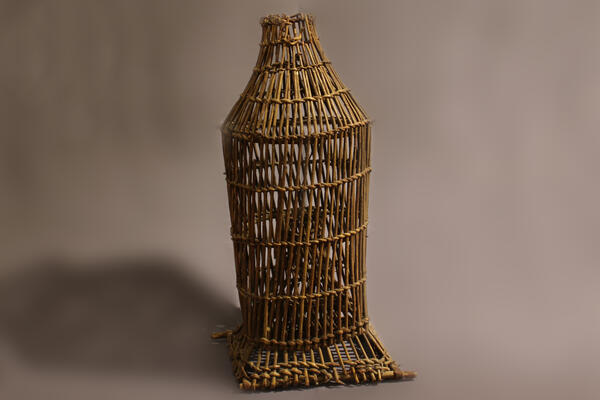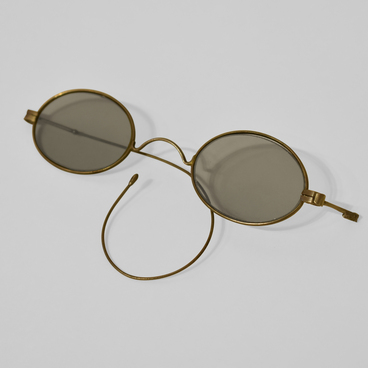Muzzle — a fishing tackle-trap known from ancient times in the form of two woven cones inserted one into the other. In length, the outer cone usually reached 1.5 m, the inner-about 70 cm. For weaving muzzles, twigs of red willow were used, pre-soaking them in hot water to give flexibility. The fish trap on display in the museum is also made of wooden rods. Russians and indigenous people used it for fishing everywhere up to modern times.
Normally, the muzzle could only be used near the shore. Before lowering it into the water, fir branches were inserted into the base of the inner cone, which lured prey. Weights were attached to the base and upper part of the muzzle, and the hole in the upper cone was plugged with hay. The trap was immersed into water so that the base would be directed towards the side of the reservoir where the fish was coming from.
Yenisey has long attracted attention for its fish diversity — the first settlers appreciated the river reserves. At that time, fish were caught only for their own needs. At the beginning of the second half of the XIX century, commercial fishing began, and the catch was about one thousand tons per year. With the beginning of steam navigation on the river in 1914, fishing developed even more rapidly. Sturgeon and salmon were considered the most valuable fish species. The largest amount of fish in Yenisey was caught at the end of the Great Patriotic war, when there were no rules and prohibitions in the industry.
Despite the considerable amount of fish living in the riverbed, there are significantly fewer of them than in other rivers. This is due to the insufficient content of food for fish in the Yenisey water — the reasons are associated with the high flow rate, rocky channel, difficult temperature regime of northern rivers, underdevelopment of the river floodplain.
The most valuable fish in Yenisey are sterlet, nelma, omul, muksun, whitefish, smelt fish and other representatives of the salmon and sturgeon family. Pike, burbot, crucian carp, perch are also found in the river. Local long-lived fish are considered taimen and sturgeon — their age sometimes gets to 60 years. Spawning of fishes in the Yenisey river does not cease throughout the year, only representatives of fish are replaced.
Normally, the muzzle could only be used near the shore. Before lowering it into the water, fir branches were inserted into the base of the inner cone, which lured prey. Weights were attached to the base and upper part of the muzzle, and the hole in the upper cone was plugged with hay. The trap was immersed into water so that the base would be directed towards the side of the reservoir where the fish was coming from.
Yenisey has long attracted attention for its fish diversity — the first settlers appreciated the river reserves. At that time, fish were caught only for their own needs. At the beginning of the second half of the XIX century, commercial fishing began, and the catch was about one thousand tons per year. With the beginning of steam navigation on the river in 1914, fishing developed even more rapidly. Sturgeon and salmon were considered the most valuable fish species. The largest amount of fish in Yenisey was caught at the end of the Great Patriotic war, when there were no rules and prohibitions in the industry.
Despite the considerable amount of fish living in the riverbed, there are significantly fewer of them than in other rivers. This is due to the insufficient content of food for fish in the Yenisey water — the reasons are associated with the high flow rate, rocky channel, difficult temperature regime of northern rivers, underdevelopment of the river floodplain.
The most valuable fish in Yenisey are sterlet, nelma, omul, muksun, whitefish, smelt fish and other representatives of the salmon and sturgeon family. Pike, burbot, crucian carp, perch are also found in the river. Local long-lived fish are considered taimen and sturgeon — their age sometimes gets to 60 years. Spawning of fishes in the Yenisey river does not cease throughout the year, only representatives of fish are replaced.



